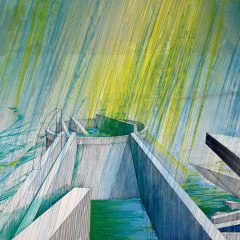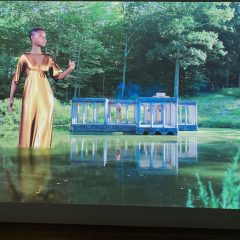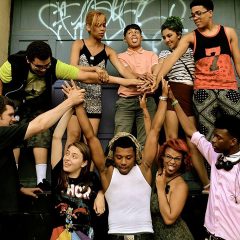The eight artists of “A Sense of Place” introduce you to fiber art as perhaps you’ve never seen it: royal ceremonial raiment made of pounded tree bark from Hawaii by Wendeanne Ke’Aka Stitt; hogs’ gut-covered tree “teeth” found on the forest floors of Maine by Pat Hickman; shredded remains of Vietnam War-era nurses uniforms turned into a hammock by Ke-Sook Lee; and a doll house by Amy Orr that is shingled inside and out with discarded credit cards.
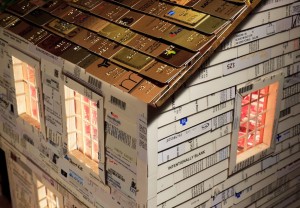
This metaphorical and entertaining group show at the Philadelphia Art Alliance is part of Fiber Philadelphia 2012, the two-month long international celebration that kicks off this weekend. And like every one of the 40 exhibits in the festival, “A Sense of Place” asks viewers to stretch their definition of fiber art to embrace the medium in the 21st century.
Fiber Philadelphia is not a conference: There are no plenary sessions and no conference hotel. The festival is about exhibitions and networking. The exhibits sprawl from Kensington to Wayne, with several large juried or curated showpiece exhibits at museums and established venues such as the Philadelphia Museum of Art, the Fabric Workshop and Museum, Crane Arts, and Moore College of Art and Design.

Directed by independent curator Bruce Hoffman and artist and educator Amy Orr, Fiber Philadelphia grows out of seven previous biennials Hoffman organized when he was curator at the blue-chip crafts gallery Snyderman-Works. Unlike past biennials, Fiber Philadelphia 2012 is an independent citywide event operating outside an institution. With the exception of their fiscal sponsor, InLiquid.com — which allows donors to Fiber Philadelphia 2012 to receive tax deductions for their contributions — the festival has no financial institutional support.
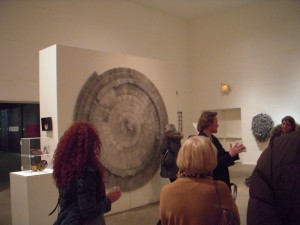
While this will be Hoffman’s eighth biennial, it’s his first as an independent curator, and Orr’s first outing as director. The two are friends. Hoffman left Snyderman a few years back after more than 20 years as curator. And Orr was ready for a career change. She quit a full-time tenured teaching position at Rosement College to focus on her art career. She has always been a community-spirited artist; she and husband, John Woodin, published The Artist’s Guide to Philadelphia from 1979 to 1991 to help artists negotiate the scene. She also helped organize the exhibits for the 2008 fiber biennial, so she knew she had experience. But it was only when she and Hoffman decided they could create the independent biennial by working outside an institution and for free that Fiber Philadelphia was born. Two years ago, they began in earnest.
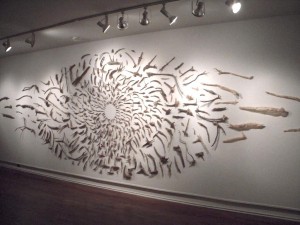
“Bruce and I agreed to not get paid,” said Orr. “We went full steam ahead. We got a donated logo; donated website; private funding; and our juried show brought in funding,” she said. More than 500 artists from 15 countries applied to be in the juried exhibit “Outside/Inside the Box” at the Crane Arts Icebox Project Space. They even got enough money from their general fundraising pool to award a top prize of $1,000 to a young artist in that show.
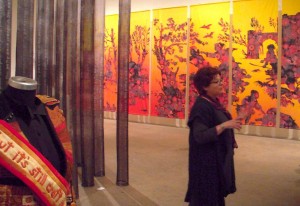
Such an undertaking requires energy and a good support network. “We have some very talented friends and we called in some favors,” said Orr.
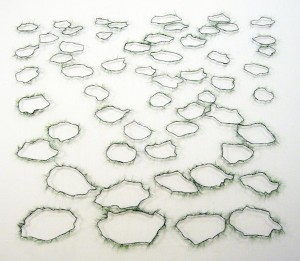
It also requires a passion for the medium, which can use some advocates right now. Fiber arts is at a crisis point in academic art institutions. “We wanted to set the stage for discussion and dialog [about fibers],” said Orr. “There’s a battle between high and low art. All fiber departments [at art schools] are morphing into design departments.” Moore College of Art and Design, for example, has eliminated its fibers major; got rid of its looms; eliminated the professional practices classes in fibers and let go of faculty, says Orr, who teaches there part-time. The battle is about space and the definition of what the field of textiles or fibers is. Moore now offers a fine arts minor in textile design focused on materials studies, and Orr doesn’t see that changing back ever. (Ironically, Moore is hosting the opening party and lecture for Fiber Philadelphia this weekend.)
Because of the impact of this high/low debate on art educators, Hoffman and Orr created a “Distinguished Educators” exhibit to honor elders in the field. “All these great teachers are being forced out, or retiring and not being replaced,” Hoffman said. “We picked thirteen, five from this area.”
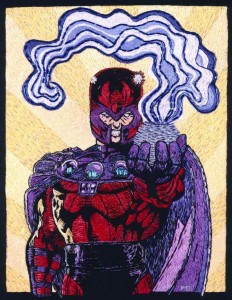
Speaking from the curator’s point of view, Art Alliance Chief Curator Sarah Archer points out that the future is coming and fibers needs to move in new directions. “Fiber will always have a close connection to the home and the body, but it’s exciting to look at those associations through the lens of sculpture and installation as well,” Archer said. “The wide array of media in [A Sense of Place] exemplifies that shift in thinking.”
Orr’s “House of Cards” is an example of where fiber art may be headed. The three-dimensional piece is not woven or stitched, but its focus on repetition, obsession, and incredible amounts of laborious work reflects the core of textile and fiber art. Orr appropriated a wood doll house that is a scale model of a real house once owned by a friend. She covered the house, inside and out, with carefully selected and positioned credit cards, insurance cards, and bank cards, all expired, all throwaways. While tiling a house with plastic bits of consumer culture may not sound like fiber art, Archer equates it to quilting. “Orr effectively ‘quilts’ using credit cards, riffing off of those traditional geometric patterns, but since she’s not using fabric, the ‘fiber’ element of her work is more in the assignment of a recognizable graphic look to her piece rather than the technique used to create it,” Archer said. “So you could consider it a kind of descendant of ‘fiber art’ as we used to know it.”
Fiber Philadelphia has its official opening tomorrow at Moore College of Art and Design, with a welcome by Mayor Nutter and a free (reservations required) keynote lecture by Elissa Auther. Artists, collectors and others interested in the field are pouring into the region to see the shows and network. And beginning 10 a.m. Saturday a low-cost shuttle bus service is available at the Art Alliance to take people to some of the other venues on the festival circuit.
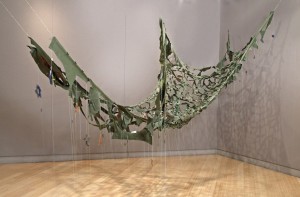
Nobody knows if Fiber Philadelphia will rise again in 2014. Orr hopes the festival will continue into the future, but unless they succeed in funding staff positions for herself and Hoffman, that may not happen. “We need money for office help and for a fundraiser and a grant writer,” she said. “We hope to have funders. We hope to have a sales component that will support us. But it won’t continue without salaries for me and Bruce. We’re still planning like it is happening. But we’re both looking for full time jobs.”
But for now, artists, galleries, and institutions appreciate the focus on fiber arts. “Events like FiberPhiladelphia are really wonderful for artists and smaller organizations,” said the Art Alliance’s Archer. “They give us a chance to connect and to show the public how we all respond to a particular theme.”
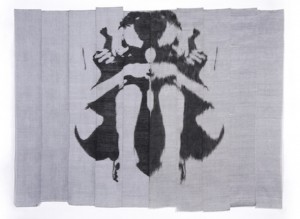
“A Sense of Place,” today through April 21, Philadelphia Art Alliance, 251 S. 18th St., 215-545-4302, www.philartalliance.org. “Fiber Philadelphia,” www.fiberphiladelphia.org.
An abbreviated version of this article appeared in the Daily News March 2 as part of Art Attack, a partnership between the newspaper and Drexel University supported by a grant from the Knight/NEA


